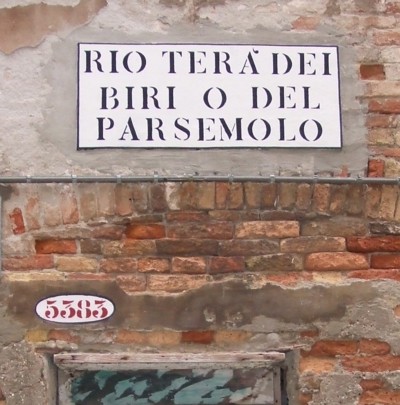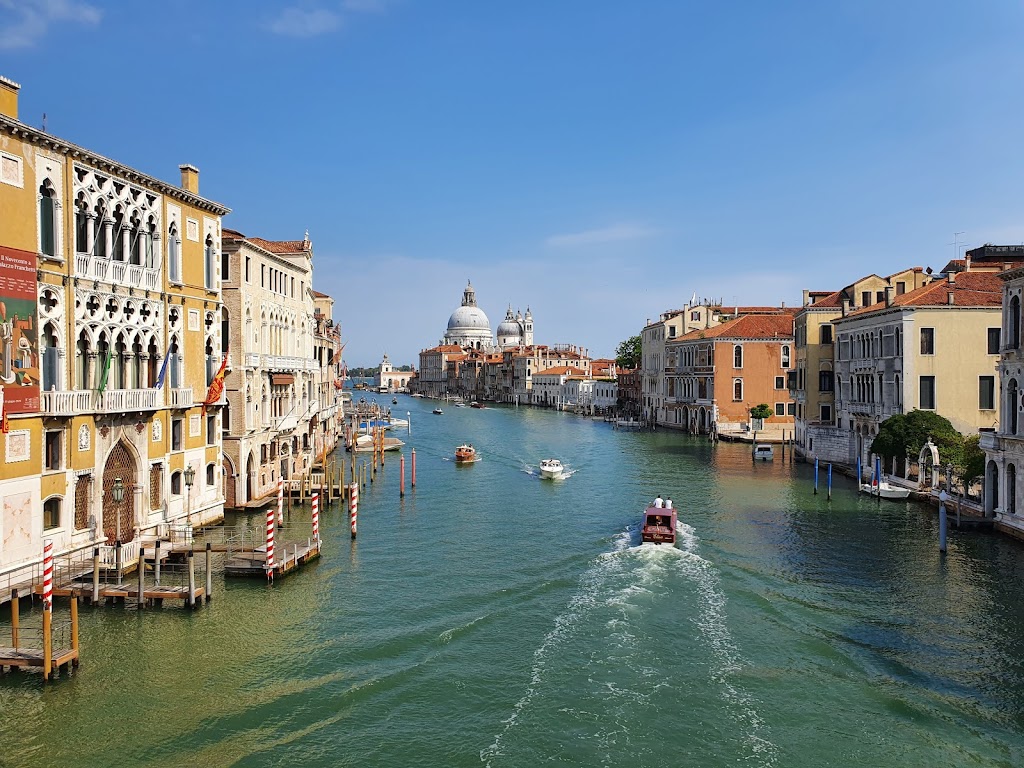Finding your way around Venice is very difficult, and you are bound to get lost, probably several times. The town is full of lost tourists with their suitcases, who can’t understand where ‘take a left, then a right’ went wrong. Almost every tourist will also tell you stories of the time they got lost and stumbled across the best sights of their trip.
Venice is not like a normal town. It is built on an agglomeration of small islands, surrounded by lagoon. The only way to get around is by boat or walking. Vaporetto (ferry) services only run along two large canals and around the outside of Venice, so unless you have a big water-taxi budget, you’ll be exploring most of Venice on foot, navigating through its maze of alleys. On this website we use words like ‘street’, ‘lane’ and ‘alley’ interchangeably. The important things to remember are that thoroughfares are pedestrian-only (keep to the right), generally just a few foot wide, and hopelessly confusing.
The problems
A typical Italian town has a few winding medieval streets superimposed on a Roman grid-plan, with some straight, modern streets added by later planners. Those town-planners and geometric Romans never had anything to do with Venice, which has its own unique set of circumstances. Buildings and lanes were fitted in around existing waterways, and more canals were dug for navigation. It used to be normal to travel by boat, so the town’s streets did not have to fulfil all the residents’ transport requirements. They are narrow because of lack of space, and because they have only ever been used by horses (long ago) and pedestrians.
Water is a constant obstacle. The Grand Canal divides the city in two and can only be crossed by using one of four bridges, or by taking a vaporetto (water-bus) or traghetto (gondola-ferry). Other, smaller canals – called rii – wind all around the many little islands of Venice, and sometimes it is quite a detour to find a bridge across.
The city is all pretty much at sea level so there are no hills to help with navigating; just the occasional glimpse of a campanile (bell-tower) to help guide you. Even a compass is not a great deal of help, as there are few straight streets and fewer direct routes.
By now you’ll begin to understand just why Venice is so tricky to navigate. All the normal logic of street-layout is suspended. Many (perhaps the majority) of streets do not lead anywhere useful, and simply provide access for local residents or businesses. Few lanes continue for a significant distance, and signposting would simply be too complex. Choices are presented every few yards – if you are navigating with a map, you’ll need to check it constantly. Few maps show every little dead-end alley, or every street name, so it can be very hard to follow their directions. Try to buy the most detailed town plan that you can find. A compass is of some assistance in an emergency, but is not really much help in choosing a route, thanks to the winding street layout and dead ends. It’s extremely easy to lose your sense of direction, and it will usually be better to ask for help than to spend ages frowning over a map. Venetians are used to giving directions, which will usually be very brief and followed by ‘sempre dritto’ (straight on).
Addresses in Venice
Addresses in Venice are even less helpful than maps, and there is practically no connection between the two. A map may tell you the name of alleys and squares, but a typical Venetian address is simply: San Marco 1323. Venice is split into districts called sestieri, and each building in a sestiere is numbered in one long consecutive sequence. Venice’s random and informal street names are not officially part of an address, although many businesses will helpfully provide one. To pin-point a location therefore, you don’t just need the brief official address, you also need a street/square name and also some helpful geographical pointer, e.g. a nearby church.
Even street names are far from straightforward. Most have evolved to describe an established location and mean descriptive things like ‘Alley of the carpenters’ or ‘Courtyard with a well’. Consequently there are often several places with the same or similar names. If you are locating a street, you will require the name of the sestiere as well (what’s more, sometimes there is more than one place with the same name in one sestiere). And even armed with official address, and street name, your task still isn’t simple.
The next confusion is that sometimes one place may have more than one name. Even one name may have different versions – many streets in Venice are known both by their dialect name and by the Italianised version. Either of these may appear on maps. This is why you’ll see many variations of placenames such as Fondamenta Nove (even throughout this website).
Streetsigns are not always easy to spot in narrow lanes. They may offer one or more variations on the name (o means ‘or’), and they are often joined on the walls by signs identifying the parish (parocchia) and any adjacent canal (rio) or bridge (ponte).
If you’re spending a long time in Venice or are just very interested in the city’s structure, there is a good book called Calli, Campielli e Canali which provides extremely large scale street plans, along with property numbers. It covers Venice and the lagoon islands, and enables you to locate any address in the city, as well as providing some background information in Italian and English on landmarks and principal buildings. You can buy it in most bookshops in Venice. Sadly, it’s rather too bulky to carry around as you explore.
What the names mean

Here are some of the most common titles for places in Venice:
Calle – a lane or alley
Campo – public open space (irregularly-shaped and less formal than a ‘piazza’). Campo means field, and once these were rough-surfaced in earth or grass, and used for burials. They are still the hubs of their neighbourhoods.Campiello – a small square or courtyard.
Corte – courtyard.
Fondamenta – canalside walkway.
Piazza – public square. There is only one in Venice, Piazza San Marco.
Ponte – bridge.
Piscina – filled-in pool of water.
Ruga – significant lane, generally one which used to contain shops.
Ramo – branch off a more important thoroughfare, whose name it takes.
Rio – canal.
Rio terrà or terà – filled-in canal, now a street.Salizzada – name given to the earliest streets to be paved.
Sottoportego – covered passage under a building, often leading only to water.
Navigating Venice – theories, routes and landmarks
You can spend many idle moments in Venice evolving navigational theories. Landmarks are all-important, both major ones and private reminders. Routes between significant points are learned this way: e.g. ‘ left by the greengrocers, straight over the square with a tree in it, down the lane between the red house and the yellow house, left past the Renaissance doorway’. Even if you’re the sort of person who has an excellent sense of direction, you’ll still find that concentrating on a chain of landmarks is more effective in Venice than working from a mental map. If you’re arriving for the first time and finding your hotel, make sure they give you simple, descriptive directions. Once you’ve found your base, memorise the route to the nearest major landmark or street (one that’s marked on your map) – then you’ll be able to find your way back. While route-finding and consulting maps, do bear in mind the Venetian rules of conduct; walk on the right and don’t block streets.
There are certain through-routes in Venice – chains of lanes linking places together. At busy times of the day you’ll see locals filing along these tortuous routes, striding down seeming dead-end alleys and darting around sharp corners. After a while you learn those of use to you, and create your own mental database of Venetian routes.
The only destinations signposted at all consistently are St. Mark’s (San Marco), the Rialto, the railway station (Ferrovia) and the bus terminus (Piazzale Roma). Even these painted signs do sometimes falter, but generally they are reliable and can help you to head in the right direction. The ones to San Marco are the most suspect, as some signposted lanes can take you a long way round (something to do with shopkeepers wanting passing trade, perhaps?).
Asking for help. At least one shop has actually put a sign on its doors refusing to help with directions. Most locals will help you, though, despite the fact that every day is plagued with tourists always looking for St. Mark’s, no matter what corner of the city they may be in. Passers-by will only point you the first step of your way; it would be impossible to describe an entire winding route.
Useful tips
1. You need a good map which shows as much detail and as many street names as possible. It’s quite useful to get hold of a decent photocopy which will save you from opening guidebooks constantly.
2. There are only four bridges across the S-shaped Grand Canal. To cross elsewhere you’ll need to take a vaporetto or traghetto.
3. Note landmarks such as churches, architectural details or even graffiti for future reference. Shops can work well to jog the memory, but when they close and pull down their shutters they sometimes become invisible.
4. Allow plenty of time, and see wandering as fun. Everyone gets lost in Venice and those are often the most magical times. Sooner or later – especially if you join a flow of passing pedestrians – you’ll end up somewhere identifiable on your map.
5. It is very, very easy to lose your sense of direction. Heading in the right direction isn’t enough – there will be canals to cross and dead ends.
Vocabulary
Scusi, per San Marco? – to St. Mark’s?
Dove siamo? (holding out a map) – where are we?
A destra – to the right
A sinistra – to the left
Sempre dritto – straight on
Grazie – thank you
On this site
